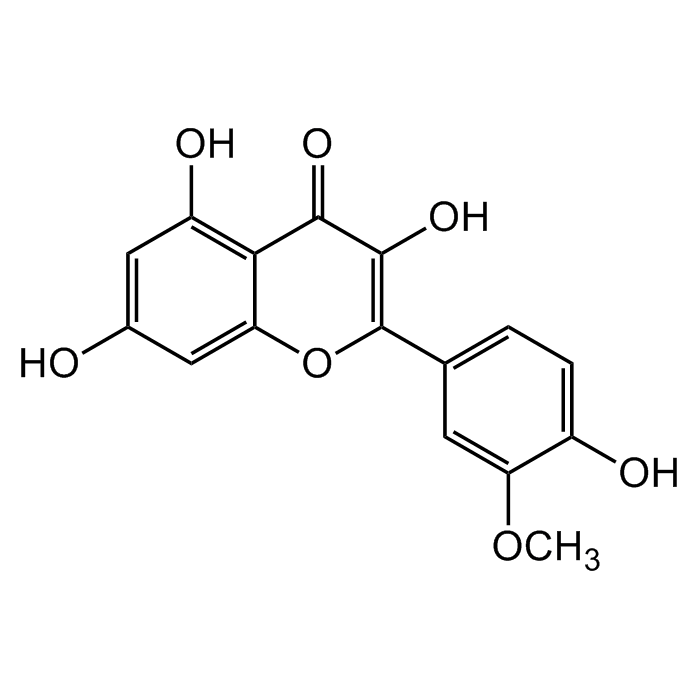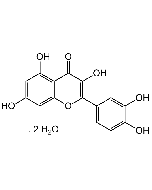Cookie Policy: This site uses cookies to improve your experience. You can find out more about our use of cookies in our Privacy Policy. By continuing to browse this site you agree to our use of cookies.
Chemodex
Isorhamnetin

| Product Details | |
|---|---|
| Synonyms | 3'-Methoxy-3,4',5,7-tetrahydroxyflavone; 3'-Methylquercetin; Isorhamnetol; Quercetin 3'-methyl ether; BRN 0044723 |
| Product Type | Chemical |
| Properties | |
| Formula |
C16H12O7 |
| MW | 316.26 |
| CAS | 480-19-3 |
| RTECS | LK9275450 |
| Purity Chemicals | ≥98% (HPLC) |
| Appearance | Beige to light yellow powder. |
| Solubility | Soluble in DMSO (20mg/ml) or DMF (10mg/ml). |
| Identity | Determined by 1H-NMR. |
| Declaration | Manufactured by Chemodex. |
| Other Product Data |
Click here for Original Manufacturer Product Datasheet |
| InChi Key | IZQSVPBOUDKVDZ-UHFFFAOYSA-N |
| Smiles | O=C1C2=C(O)C=C(O)C=C2OC(C3=CC=C(O)C(OC)=C3)=C1O |
| Shipping and Handling | |
| Shipping | AMBIENT |
| Short Term Storage | +20°C |
| Long Term Storage | +4°C |
| Handling Advice | Protect from light and moisture. |
| Use/Stability | Stable for at least 2 years after receipt when stored at +4°C. |
| Documents | |
| Product Specification Sheet | |
| Datasheet |
 Download PDF Download PDF |
Isorhamnetin is a natural flavonol aglycone that is the 3-methyl metabolite of quercetin. It shows diverse biological activities, including antioxidant, cardioprotective, anti-inflammatory, neuroprotective, antiobesity, antiviral, antituberculosis and anticancer properties. Isorhamnetin exerts anticancer activity, through induction of apoptosis and inhibition of cell proliferation and invasion. It suppresses colon cancer cell growth through the PI3K-Akt-mTOR pathway. It inhibits the NF-κB signaling pathway. Isorhamnetin selectively inhibited NLRP3 and AIM2 inflammasome activation and down-regulated expression of pro-inflammatory cytokines. It has powerful antioxidant action through its ability to scavenge free radicals and inhibits xanthine oxidase. Isorhamnetin is a PPARγ antagonist and inhibits adipogenesis, with beneficial effect on the prevention and treatment of obesity.
(1) A. Nagao, et al. Biosci. Biotechnol. Biochem. 63, 1787 (1999) | (2) B.S. Teng, et al.; Pharmacol. Res. 54, 186 (2006) | (3) G. Ma, et al.; Chem. Biol. Interact. 167, 153 (2007) | (4) M. Sanchez, et al.; J. Nutr. 137, 910 (2007) | (5) L. Pengfei, et al.; Plant Foods Hum. Nutr. 64, 141 (2009) | (6) S. Jaramillo, et al.; J. Agric. Food Chem. 58, 10869 (2010) | (7) L. Ramachandran, et al.; J. Biol. Chem. 287, 38028 (2012) | (8) J.H. Yang, et al.; Food Chem. Toxicol. 59, 362 (2013) | (9) C. Li, et al.; Mol. Med. Rep. 9, 935 (2014) | (10) S. Chirumbolo; Inflammation 37, 1200 (2014) | (11) A. Abdal Dayem, et al.; PLoS One 10, e0121610 (2015) | (12) H.N. Jnawali, et al.; J. Nat. Prod. 79, 961 (2016) | (13) Y. Zhang, et al.; Sci. Rep. 6, 19288 (2016) | (14) H. Ahn & G.S. Lee; Phytomedicine 24, 77 (2017) | (15) J. Wei, et al.; Exp. Ther. Med. 15, 3917 (2018)






